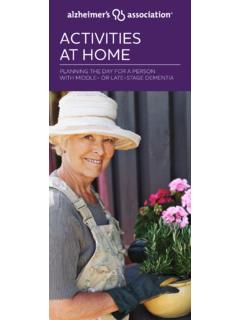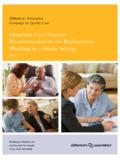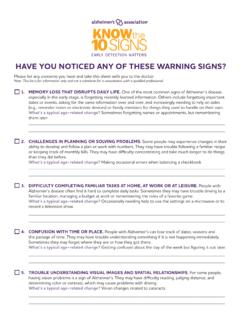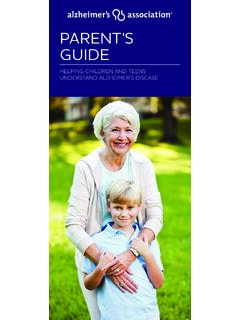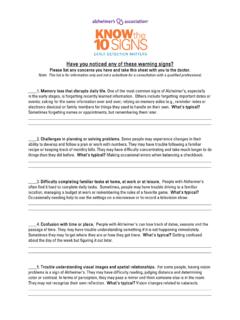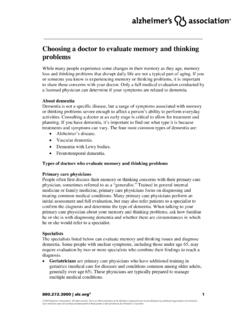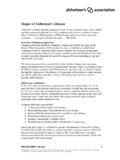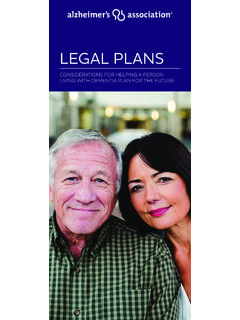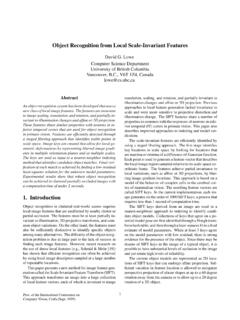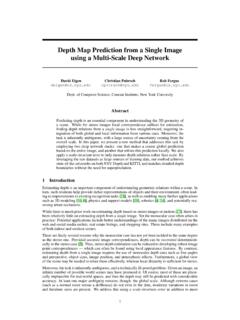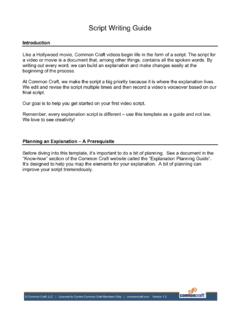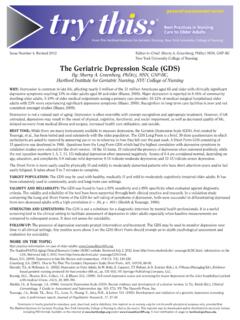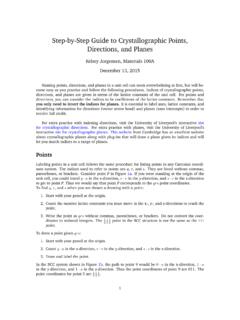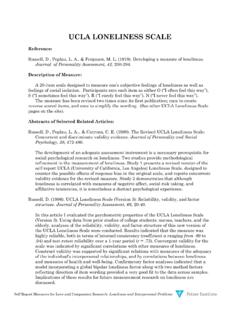Transcription of Katz Index of Independence in Activities of Daily Living
1 Patient Name:_____ Date:_____ Patient ID #_____ Katz Index of Independence in Activities of Daily Living Activities Points (1 or 0) Independence (1 Point) NO supervision, direction or personal assistance. Dependence (0 Points) WITH supervision, direction, personal assistance or total care. BATHING Points: _____ (1 POINT) Bathes self completely or needs help in bathing only a single part of the body such as the back, genital area or disabled extremity. (0 POINTS) Need help with bathing more than one part of the body, getting in or out of the tub or shower. Requires total bathing DRESSING Points: _____ (1 POINT) Get clothes from closets and drawers and puts on clothes and outer garments complete with fasteners. May have help tying shoes. (0 POINTS) Needs help with dressing self or needs to be completely dressed. TOILETING Points: _____ (1 POINT) Goes to toilet, gets on and off, arranges clothes, cleans genital area without help.
2 (0 POINTS) Needs help transferring to the toilet, cleaning self or uses bedpan or commode. TRANSFERRING Points: _____ (1 POINT) Moves in and out of bed or chair unassisted. Mechanical transfer aids are acceptable (0 POINTS) Needs help in moving from bed to chair or requires a complete transfer. CONTINENCE Points: _____ (1 POINT) Exercises complete self control over urination and defecation. (0 POINTS) Is partially or totally incontinent of bowel or bladder FEEDING Points: _____ (1 POINT) Gets food from plate into mouth without help. Preparation of food may be done by another person. (0 POINTS) Needs partial or total help with feeding or requires parenteral feeding. TOTAL POINTS: _____ SCORING: 6 = High (patient independent) 0 = Low (patient very dependent Source: try this: Best Practices in Nursing Care to Older Adults, The Hartford Institute for Geriatric Nursing, New York University, College of Nursing, From The Hartford Institute for Geriatric Nursing, New York University, College of NursingBest Practices in Nursing Care to Older Adultsgeneral assessment seriesIssue Number 2, Revised 2007 Series Editor: Marie Boltz, PhD, GNP-BCSeries Co-Editor: Sherry A.)
3 Greenberg, MSN, GNP-BCNew York University College of NursingKatz Index of Independence in Activities of Daily Living (ADL) By: Meredith Wallace, PhD, APRN, BC, Fairfield University School of Nursing, and Mary Shelkey, PhD, ARNP, Virginia Mason Medical CenterWHY: Normal aging changes and health problems frequently show themselves as declines in the functional status of older adults. Decline may place the older adult on a spiral of iatrogenesis leading to further health problems. One of the best ways to evaluate the health status of older adults is through functional assessment which provides objective data that may indicate future decline or improvement in health status, allowing the nurse to intervene TOOL: The Katz Index of Independence in Activities of Daily Living , commonly referred to as the Katz ADL, is the most appropriate instrument to assess functional status as a measurement of the client s ability to perform Activities of Daily Living independently.
4 Clinicians typically use the tool to detect problems in performing Activities of Daily Living and to plan care accordingly. The Index ranks adequacy of performance in the six functions of bathing, dressing, toileting, transferring, continence, and feeding. Clients are scored yes/no for Independence in each of the six functions. A score of 6 indicates full function, 4 indicates moderate impairment, and 2 or less indicates severe functional POPULATION: The instrument is most effectively used among older adults in a variety of care settings, when baseline measurements, taken when the client is well, are compared to periodic or subsequent AND RELIABILITY: In the thirty-five years since the instrument has been developed, it has been modified and simplified and different approaches to scoring have been used. However, it has consistently demonstrated its utility in evaluating functional status in the elderly population.
5 Although no formal reliability and validity reports could be found in the literature, the tool is used extensively as a flag signaling functional capabilities of older adults in clinical and home AND LIMITATIONS: The Katz ADL Index assesses basic Activities of Daily Living . It does not assess more advanced Activities of Daily Living . Katz developed another scale for instrumental Activities of Daily Living such as heavy housework, shopping, managing finances and telephoning. Although the Katz ADL Index is sensitive to changes in declining health status, it is limited in its ability to measure small increments of change seen in the rehabilitation of older adults. A full comprehensive geriatric assessment should follow when appropriate. The Katz ADL Index is very useful in creating a common language about patient function for all practitioners involved in overall care planning and discharge ON THE TOPIC:Best practice information on care of older adults: , C.
6 (2006). Functional decline in hospitalized older adults. AJN, 106(1), , S., Down, , Cash, , & Grotz, (1970) Progress in the development of the Index of ADL. The Gerontologist, 10(1), , S. (1983). Assessing self-maintenance: Activities of Daily Living , mobility and instrumental Activities of Daily Living . JAGS, 31(12), , , & Mezey, M. (2003). Assessment of function. In M. Mezey, T. Fulmer, I. Abraham (Eds.), D. Zwicker (Managing Ed.), Geriatric nursing protocols for best practice (2nd ed., pp 31-46). NY: Springer Publishing Co., Inc. Mick, , & Ackerman, (2004, Sept). Critical care nursing for older adults: Pathophysiological and functional considerations. Nursing Clinics of North America, 39(3), is hereby granted to reproduce, post, download, and/or distribute, this material in its entirety only for not-for-profit educational purposes only, provided that The Hartford Institute for Geriatric Nursing, New York University, College of Nursing is cited as the source.
7 This material may be downloaded and/or distributed in electronic format, including PDA format. Available on the internet at and/or E-mail notification of usage to.
